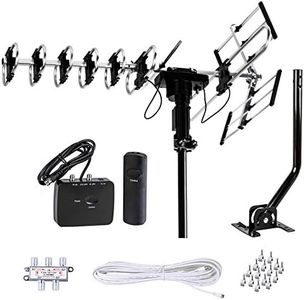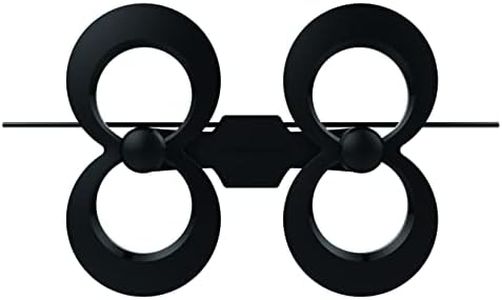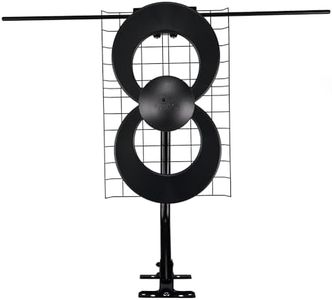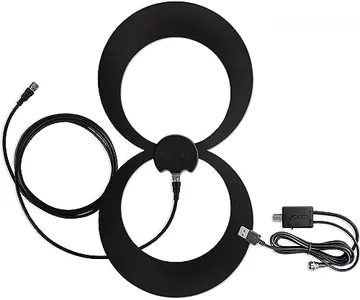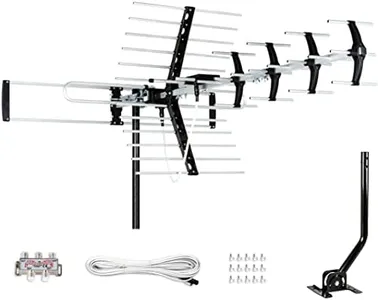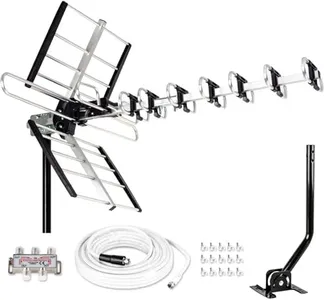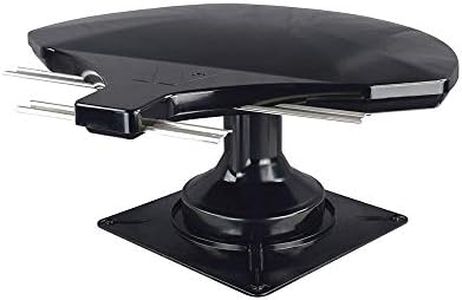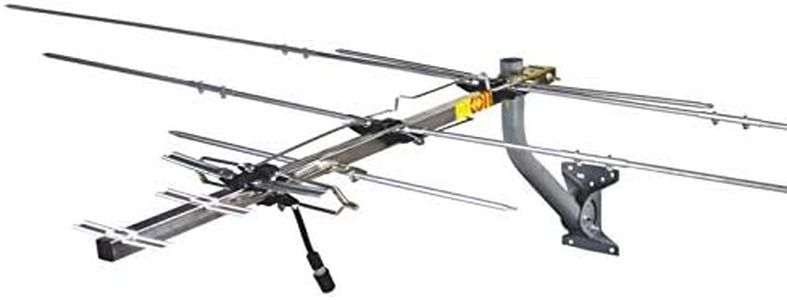10 Best TV Antennas 2025 in the United States
Our technology thoroughly searches through the online shopping world, reviewing hundreds of sites. We then process and analyze this information, updating in real-time to bring you the latest top-rated products. This way, you always get the best and most current options available.

Our Top Picks
Winner
Antennas Direct ClearStream MAX-V PRO Indoor Outdoor TV Antenna, UHF VHF, Multi-Directional, 70+ Mile Range, 4K 8K UHD, NEXTGEN TV – w/Wall Bracket
Most important from
79 reviews
The Antennas Direct ClearStream MAX-V PRO TV Antenna is a versatile choice for anyone looking for both indoor and outdoor antenna solutions. With a signal range of over 70 miles, it is well-suited for suburban and rural areas where broadcast towers may be distant. The multi-directional design, featuring four patented loops, ensures good reception of both UHF and VHF signals, which makes it compatible with 4K and 8K UHD as well as NEXTGEN TV standards. This means you do not need an internet connection to access high-definition channels.
One of the major strengths of this antenna is its flexibility in installation. It includes all necessary hardware for mounting on a wall, an existing mast, or even indoors, making it adaptable to various environments and conditions. The antenna is built with durable materials, suggesting it can withstand outdoor elements if needed.
However, the size of 31.3” wide by 17.4” high can be a bit cumbersome for some users, especially if space is limited. Assembly is minimal but required, which might be a slight inconvenience for those not inclined towards DIY setups. This antenna is ideal for those in need of a strong, flexible, and high-quality solution for their TV signal needs, particularly in areas with varying signal strengths and obstructions.
Most important from
79 reviews
Antennas Direct ClearStream 2V Indoor Outdoor TV Antenna UHF VHF Multi-Directional, 60+ Mile Range, 4K 8K UHD, NEXTGEN TV – w/Reflector, 20-inch Mast
Most important from
6214 reviews
The Antennas Direct ClearStream 2V is a versatile TV antenna designed for both indoor and outdoor use, making it a solid choice for people living in suburban or rural areas where signal range and strength can vary. It supports both UHF and VHF signals, allowing it to pick up a wide variety of channels, including the latest 4K and 8K broadcasts without the need for internet. With a 60+ mile range, it handles long-distance signals better than many indoor-only antennas.
The antenna is multi-directional, so you don’t have to constantly adjust it to catch signals from different directions, which is convenient if TV towers are spread out around you. A unique feature is its reflector that focuses the signal to reduce interference and picture issues like pixelation, helping to maintain a clear image. The antenna’s size is relatively large but comes with a 20-inch mast and a pivoting base that offers flexible mounting options on walls, attics, or rooftops. However, the size might not suit everyone looking for a discreet indoor antenna. It’s amplified, which boosts weaker signals, but performance can still be affected by obstacles like trees or building materials.
While it’s not designed to replace cable or satellite TV channels, it excels at delivering free over-the-air broadcasts. The product comes with all necessary mounting hardware and has a strong reputation backed by a lifetime warranty on the antenna itself. This antenna is well-suited for users seeking a reliable, high-quality signal for a variety of free broadcasts over a long distance, especially in areas where signals come from multiple directions. It may be less ideal for those with limited space or who live in dense urban environments where a smaller indoor antenna might suffice.
Most important from
6214 reviews
Antennas Direct ClearStream Eclipse 2 Amplified UHF Indoor TV Antenna, Reversible, 60+ Mile Range – w/ 12 ft. Cable, Jolt Switch Amplifier
Most important from
347 reviews
The Antennas Direct ClearStream Eclipse 2 is an indoor TV antenna designed to pick up free broadcast channels up to 60 miles away, making it a solid choice for people living within a moderate distance from TV towers. Its ultra-thin, reversible design is a standout feature — the antenna is very slim and can be painted to blend with your wall or furniture, helping it stay discreet indoors. It uses a multi-directional UHF element, meaning it can catch signals from various directions without needing to be constantly adjusted. The included Jolt Switch amplifier gives you control over boosting the signal strength when needed, which is helpful if you live in an area with weaker reception or more obstacles like walls and trees.
This antenna only supports UHF signals, so if you want VHF channels as well, this might limit what you can receive. Being an indoor antenna, it’s best suited for those who want an easy setup without mounting outside. The 12-foot cable adds flexibility for positioning. While it does a good job with modern digital signals including 4K and Full HD, it won’t deliver cable or satellite channels. Some users may find the range less effective if there are many obstructions or if they live farther than 60 miles from broadcast towers.
The small size and lightweight design make it easy to mount or place discreetly, but if you want a directional antenna for targeting a specific tower, this multi-directional model may be less precise. It successfully balances a sleek look with practical signal boosting in an indoor setup, making it a convenient option for urban or suburban users aiming to cut cable bills.
Most important from
347 reviews
Buying Guide for the Best TV Antennas
Choosing the right TV antenna can greatly improve the quality of your TV signal and let you enjoy more channels with better clarity. Because TV signals come from broadcast towers and not all homes have the same location or setup, it's important to understand a few key specifications of antennas so you can get the one that best fits your needs.FAQ
Most Popular Categories Right Now
